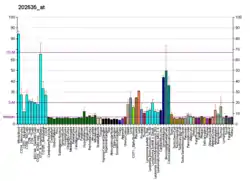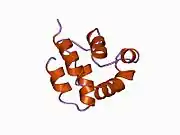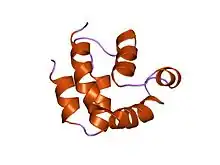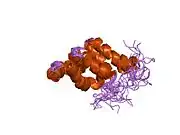FADD
پروتئین مرتبط با فاس و دارای دومین مرگ (انگلیسی: Fas-associated protein with death domain) یا بهاختصار «FADD» که با نام «MORT1» هم شناخته میشود، نام پروتئینی است که در انسان توسط ژن «FADD» ب روی بازوی بلند کروموزوم ۱۱ کدگذاری میشود.[3]
این مولکول یک پروتئین وفقدهنده ترارسانی پیام است که اعضای ابرخانواده گیرندههای فاکتور نکروز تومور همچون گیرنده فاس را به کاسپاز ۸ و کاسپاز ۱۰ در جریان فرایند آپوپتوز مرتبط میسازد.
این پروتئین علاوه بر آپوپتوز،[4][5] در نکروپتوز، مرگ سلولی از طریق خودخواری،[6] رویانزایی،[7] تنظیم چرخهٔ سلولی در لنفوسیت تی،[8] تزاید و تکثیر لنفوسیت تی،[9] التهاب،[10][11] پاسخ سیستم ایمنی علیه ویروسها[12] و تنظیم سطح گلوکز[13] نقش دارد.
سطح FADD در بیماریهایی چون اماس،[14] روماتیسم مفصلی، سرطان تخمدان،[15] سرطان ریه و سرطانهای سر و گردن بالا میرود. در مورد سرطانها، هرچه سطح FADD بالاتر باشد، پیشآگهی آنها بدتر است.[16]
منابع
- "Human PubMed Reference:". National Center for Biotechnology Information, U.S. National Library of Medicine.
- "Mouse PubMed Reference:". National Center for Biotechnology Information, U.S. National Library of Medicine.
- Kim, P.K.M.; Dutra, A.S.; Chandrasekharappa, S.C.; PUCK, J.M (1996). "Genomic structure and mapping of human FADD, an intracellular mediator of lymphocyte apoptosis". Journal of Immunology. 157 (12): 5461–5466. PMID 8955195.
- Micheau, O.; Tschopp, J. (2003). "Induction of TNF receptor I-mediated apoptosis via two sequential signaling complexes". Cell. 114 (2): 181–190. doi:10.1016/s0092-8674(03)00521-x. PMID 12887920.
- Bodmer JL, Holler N, Reynard S, Vinciguerra P, Schneider P, Juo P, Blenis J, Tschopp J (2000). "TRAIL receptor-2 signals apoptosis through FADD and caspase-8". Nature Cell Biology. 2 (4): 241–243. doi:10.1038/35008667. PMID 10783243.
- Pyo JO, Jang MH, Kwon YK, Lee HJ, Jun JI, Woo HN, Cho DH, Choi B, Lee H, Kim JH, Mizushima N, Oshumi Y, Jung YK (2005). "Essential roles of Atg5 and FADD in autophagic cell death - Dissection of autophagic cell death into vacuole formation and cell death". Journal of Biological Chemistry. 280 (21): 20722–20729. doi:10.1074/jbc.M413934200. PMID 15778222.
- Yeh, W. C.; De La Pompa, J. L.; Mccurach, M. E.; Shu, H. B.; Elia, A. J.; Shahinian, A.; Ng, M.; Wakeham, A.; Khoo, W.; Mitchell, K.; El-Deiry, W. S.; Lowe, S. W.; Goeddel, D. V.; Mak, T. W. (1998). "FADD: Essential for embryo development and signaling from some, but not all, inducers of apoptosis". Science. 279 (5358): 1954–1958. doi:10.1126/science.279.5358.1954. PMID 9506948.
- Alappat EC, Feig C, Boyerinas B, Volkland J, Samuels M, Murmann AE, Thorburn A, Kidd VJ, Slaughter CA, Osborn SL, Winoto A, Tang WJ, Peter ME (2005). "Phosphorylation of FADD at serine 194 by CKI alpha regulates its nonapoptotic activities". Molecular Cell. 19 (3): 321–332. doi:10.1016/j.molcel.2005.06.024. PMID 16061179.
- Zhang J, Cado D, Chen A, Kabra NH, Winoto A (1998). "Fas-mediated apoptosis and activation-induced T-cell proliferation are defective in mice lacking FADD/Mort1". Nature. 392 (6673): 296–300. doi:10.1038/32681. PMID 9521326.
- Wajant H, Haas E, Schwenzer R, Muhlenbeck F, Kreuz S, Schubert G, Grell M, Smith C, Scheurich P (2000). "Inhibition of death receptor-mediated gene induction by a cycloheximide-sensitive factor occurs at the level of or upstream of Fas-associated death domain protein (FADD)". Journal of Biological Chemistry. 275 (32): 24357–24366. doi:10.1074/jbc.M000811200. PMID 10823821.
- Tourneur L, Chiocchia G (2010). "FADD: a regulator of life and death". Trends in Immunology. 31 (7): 260–269. doi:10.1016/j.it.2010.05.005. PMID 20576468.
- Balachandran, S.; Venkataraman, T.; Fisher, P. B.; Barber, G. N (2007). "Fas-associated death domain-containing protein-mediated antiviral innate immune signaling involves the regulation of Irf7". Journal of Immunology. 178 (4): 2429–2439. doi:10.4049/jimmunol.178.4.2429. PMID 17277150.
- Yao C, Zhuang H, Du P, Cheng W, Yang B, Guan S, Hu Y, Zhu D, Christine M, Shi L, Hua ZC (2013). "Domain-containing Protein (FADD) Phosphorylation in Regulating Glucose Homeostasis: from Proteomic Discovery to Physiological Validation". Molecular & Cellular Proteomics. 12 (10): 2689–2700. doi:10.1074/mcp.M113.029306. PMID 23828893.
- Reuss R, Mistarz M, Mirau A, Kraus J, Bödeker RH, Oschmann P (2014). "FADD is upregulated in relapsing remitting multiple". Neuroimmunomodulation. 21 (5): 221–225. doi:10.1159/000356522. PMID 24603611.
- Razaghi, Ali; Villacrés, Carina; Jung, Vincent; Mashkour, Narges; Butler, Michael; Owens, Leigh; Heimann, Kirsten. "Improved therapeutic efficacy of mammalian expressed-recombinant interferon gamma against ovarian cancer cells". Experimental Cell Research. 359 (1): 20–29. doi:10.1016/j.yexcr.2017.08.014.
- Cimino Y, Costes A, Damotte D, Validire P, Mistou S, Cagnard N, Alifano M, Régnard JF, Chiocchia G, Sautès-Fridman C, Tourneur L (2012). "FADD protein release mirrors the development and aggressiveness of human non-small cell lung cancer". British Journal of Cancer. 106 (12): 1989–1996. doi:10.1038/bjc.2012.196. PMC 3388563. PMID 22669160.
- مشارکتکنندگان ویکیپدیا. «FADD». در دانشنامهٔ ویکیپدیای انگلیسی، بازبینیشده در ۱۹ ژانویه ۲۰۱۸.
بیشتر بخوانید
- Bolze A, Byun M, McDonald D, Morgan NV, Abhyankar A, Premkumar L, Puel A, Bacon CM, Rieux-Laucat F, Pang K, Britland A, Abel L, Cant A, Maher ER, Riedl SJ, Hambleton S, Casanova JL (2010). "Whole-Exome-Sequencing-Based Discovery of Human FADD Deficiency". Journal of Human Genetics. 87: 873–881. doi:10.1016/j.ajhg.2010.10.028. PMC 2997374. PMID 21109225.
- Werner MH, Wu C, Walsh CM (2006). "Emerging roles for the death adaptor FADD in death receptor avidity and cell cycle regulation". Cell Cycle. 5 (20): 2332–2338. doi:10.4161/cc.5.20.3385. PMID 17102623.
- Yu JW, Shi Y (2008). "FLIP and the death effector domain family". Oncogene. 27 (48): 6216–6227. doi:10.1038/onc.2008.299. PMID 18931689.
- Bhojani MS, Chen G, Ross BD, Beer DG, Rehemtulla A (2007). "Nuclear localized phosphorylated FADD induces cell proliferation and is associated with aggressive lung cancer". Cell Cycle. 4 (11): 1478–81. doi:10.4161/cc.4.11.2188. PMID 16258269.
پیوند به بیرون
- Fas-Associating Protein with Death Domain در سرعنوانهای موضوعی پزشکی (MeSH) در کتابخانهٔ ملی پزشکی ایالات متحدهٔ آمریکا






